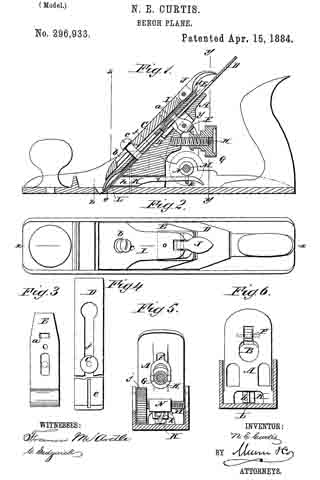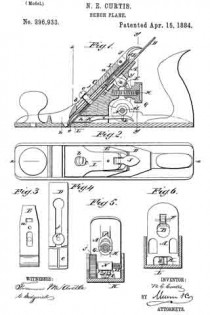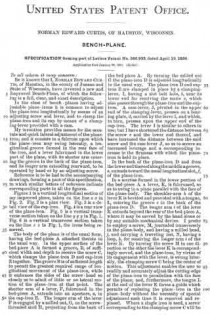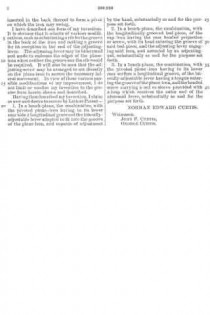No. 296,933 – Bench-Plane (Norman Edward Curtis) (1884)

UNITED STATES PATENT OFFICE.
_________________
NORMAN EDWARD CURTIS, OF MAUSTON, WISCONSIN.
BENCH-PLANE.
_________________
SPECIFICATION forming part of Letters Patent No. 296,933, dated April 15, 1884.
Application filed January 28, 1884. (Model.)
_________________
To all whom it may concern:
Be it known that I, NORMAN EDWARD CURTIS, of Mauston, in the county of Juneau and State of Wisconsin, have invented a new and Improved Bench-Plane, of which the following is a full, clear, and exact description.
In the class of bench-planes having adjustable plane-irons it is common to adjust the plane-iron longitudinally by means of an adjusting screw and lever, and to clamp the plane-iron and its cap by means of a clamping-lever provided with a cam.
My invention provides means for the accurate and quick lateral adjustment of the plane-iron, and it consists in a fulcrum upon which the plane-iron may swing laterally, a longitudinal groove formed in the rear face of the iron, and a lever fulcrumed in the lower part of the plane, with its shorter arm entering the groove in the back of the plane-iron, and its longer arm extending rearward, to be operated by hand or by an adjusting-screw.
Reference is to be had to the accompanying drawings, forming a part of this specification, in which similar letters of reference indicate corresponding parts in all the figures.
Figure 1 is a vertical longitudinal section of my improved plane, taken on the line x x in Fig. 2. Fig. 2 is a plan view. Fig. 3 is a detail view of the cap-iron. Fig. 4 is a rear view of the plane-iron. Fig. 5 is a vertical transverse section taken on the line y y y in Fig. 1. Fig. 6 is a vertical transverse section taken on the line z z in Fig. 1, the irons being removed.
The body of the plane is of the usual form, having the bed-piece A attached thereto in the usual way. In the upper surface of the bed-piece A is formed a groove, B, of sufficient width and depth to receive the screw C, which clamps the plane-iron D and cap-iron E together. The groove B is of sufficient length to permit the greatest required range of longitudinal rnovement of the plane-iron, while it embraces the sides of the screw-head so closely as to admit of little or no lateral motion of the plane-iron at that point. The shorter arm of a lever, F, fulcrumed in the bed-piece A, extends into an aperture, a, in the cap-iron E. The longer arm of the lever F is engaged by a milled nut, G, on the screw-threaded stud H, projecting from the back of the bed-piece A. By turning the milled nut G the plane-iron D is adjusted longitudinally in the usual way. The plane-iron D and cap-iron E are clamped in place by a clamping-lever, I, having a slot bolt hole, b, near its lower end for receiving the screw c, which also passes through the plane-iron and the cap-iron. A cam-lever, J, pivoted in the upper end of the clamping-lever, presses on a bearing plate, d, carried by the lever I, and which, in turn, presses upon the upper end of the cap-iron. The lever I is similar to others in use; but lf have shortened the distance between the screw c and the lower end thereof, and have increased the distance between the said screw and the cam-lever J, so as to secure an increased leverage and a corresponding increase in the firmness with which the plane-iron is held in place.
In the back of the plane-iron D and from the lower end thereof along the middle a groove, e, extends toward the usual longitudinal slot, f, of the plane-iron.
In a mortise formed in the lower portion of the bed-piece A a lever, K, is fulcrumed, so as to swing in a plane parallel with the face of the plane-body. The shoulder-arm h of the lever K is beveled and provided with a tongue, L, entering the groove e in the back of the plane-iron D. The longer arm i of the lever K, extends beyond the rear of the bed-piece A, where it may be moved by the hand alone or by any suitable mechanical device. I prefer to employ a screw, M, journaled transversely in the plane-body, and having a milled head, j, and carrying a traveling nut, N, having a loop, k, for receiving the longer arm i of the lever K. By turning the screw M in one direction or the other the lever K is correspondingly moved, and the plane-iron, by virtue of its engagement with the lever, is swung laterally, the clamping-screw C being the center of motion. This adjustment enables the user to readily and accurately adjust the cutting-edge of the plane-iron to parallelism with the face of the plane; and, furthermore, the tongue L at the end of the lever K forms a guide which permits of replacing the plane-iron in the plane-body without the necessity of special adjustment each time it is removed and replaced. Where a single iron is used, a screw corresponding to the clamping-screw C will be inserted in the back thereof to form a pivot on which the iron may swing.
I have described one term of my invention. It is obvious that it adrnits of various modifications, such as substituting a rib for the groove in the back of the iron and making a groove for its reception in the end of the adjusting-lever. The adjusting-lever may be bifurcated and made to embrace the edges of the plane-iron when neither the groove nor the rib would be required. It will also be seen that the adjusting-screw may be arranged to act directly on the plane-iron to secure the necessary lateral movement. In view of these various possible modifications of my improvement, I do not limit or confine my invention to the precise form herein shown and described.
Having described my invention, I claim as new and desire to secure by Letters Patent —
1. In a bench-plane, the combination, with the pivoted plane-iron having in its lower rear side a longitudinal groove of the laterally-adjustable lever adapted to fit into the groove of the plane iron, and capable of adjustment by the hand, substantially as and for the purpose set forth.
2. In a bench-plane, the combination, with the longitudinally-grooved bed-piece, of the cap-iron having the rear headed projection or screw, with its head entering the groove of said bed-piece, and the adjusting-lever engaging said iron, and actuated by an adjusting-nut, substantially as and for the purpose set forth.
3. In a bench-plane, the combination, with the pivoted plane-iron having in its lower rear surface a longitudinal groove, of the laterally-adjustable lever having a tongue entering the groove of the plane-iron, and the headed screw carrying a nut or sleeve provided with a loop which receives the outer end of the aforesaid lever, substantially as and for the purpose set forth.
NORMAN EDWARD CURTIS.
Witnesses:
JOHN F. CURTIS,
GEORGE CURTIS.



